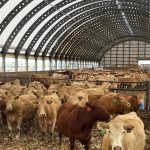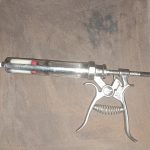Sow and Grow with Sara: Harvest Safety
Photo Caption: Be mindful of your safety around equipment this fall! Photo Credit: Sara Bauder
Although I mention it every year, we’re all human and tend to be forgetful or complacent, so I find it valuable to discuss roadway and harvest safety each fall. According to the Bureau of Labor and Statistics, in 2023, about 2.3 million workers were employed in ag or ag related industry in the US. According to the CDC, between 2021 and 2022, there were 21,020 injuries in ag production that resulted in days away from work in the US (there is a well-known underreporting of injuries in the ag industry as well). Almost 1/3 of injuries from ag production (requiring days away from work) in ’21 and ’22 were from falls. In 2022 alone, workers in ag, forestry, fishing, and hunting had one of the highest fatal injury rates of 18.6 deaths per 100,000 full-time equivalents (FTEs) as compared to all other industries at 3.7 deaths per 100,000 FTEs. Transportation incidents were the leading cause of death for farmers and farm workers within this data (cdc.gov). Here are a few tips and reminders to avoid becoming a safety statistic this season.
Roadway Travel
If a vehicle travels at 65 mph and a tractor and grain cart is one-half mile ahead of it traveling at 15 mph in the same direction… it would take 36 seconds for your vehicle to meet the grain cart. Consider cutting the distance to a quarter of a mile, that’s only 18 seconds. With all the potential distractions drivers face, one can see how an accident like this could occur. In order to keep yourself and others safe please take time to consider the following:
Farmers:
· Avoid traveling after sunset and during times when more traffic is expected.
· Be sure all safety lights are on and working, and all placards are visible.
· Avoid parking on roadways, but if it’s necessary to do so, ensure proper safety lights are used.
· If it’s muddy, clean tires and equipment well enough to avoid leaving mud on the roadway.
· Transport combine heads separately from the combine when moving on a roadway.
· Avoid driving distractions such as cell phones.
Auto Drivers:
· Be patient. Harvest occurs during a short period of the year; quite often, large equipment operators will pull over and allow you to pass when they are able.
· Leave as much room as possible when meeting large equipment on the road. If the shoulders are good, do not be afraid to slow down and use them.
· When passing machinery be sure to double check for oncoming traffic, slow down, and look for turn signals IF the equipment has them. Remember that the equipment operator may be unable to see behind them, making passing very dangerous.
· As should be done with any other vehicle, avoid tailgating; it is impossible to know when a sudden stop may be necessary.
Grain Handling Safety
Many of you will be hauling and storing grain this fall. In 2024 alone, 51 cases of agriculture confined space incidents were documented, with 43% being fatal (down slightly from the historic 58% average). The US had 34 reported grain entrapments, a 25% increase from 2023 (Purdue, 2025).
The big issue here, in my opinion, is that many farmers practice grain handling and storage so frequently, that we become complacent. When you do something very frequently, it’s quite easy to forget how dangerous it can be. Here are a few specific safety precautions to think about this year:
· Entanglement/Engulfment
o Always lock/tag out unloading equipment before entering bins or doing maintenance.
o Always wear a lifeline or safety harness before entering bins. A body harness is best as it spreads the force of a fall or a tug of the rope across a larger area of the body. Waist belts can cause serious injury when used to stop a fall.
o Never work alone in a bin- have someone watching outside the bin that can contact you and call for help.
· Falls
o Use the 3-4-1 triangle for ladders. Extend ladder 3 feet above surface; for every 4 feet of height, place ladder 1 foot away from surface.
o Improve bin ladders by adding a cage; raise the bottom of the ladder so that children cannot reach the bottom rung. Add handrails at the end of the ladder (for easy transition to the roof) and guardrails along the roof ladder if possible.
o Rather than relying on rope, chain, or pipe ladders, farmers should use an attached interior ladder. It helps to paint the ladder or wall behind it a bright color to help detect its location in dusty conditions.
· Entanglement/Moving Equipment
o Keep all guards and shields in place at all times.
o Block tires and lock raised beds. Lock hydraulics and mechanisms.
· Electrical/Fire
o Lower augers, ladders, etc. to avoid hitting any electrical lines.
o Limit all ignition sources and perform maintenance regularly.
o Check bins for grain condition and heating during storage periods.
Resources: · https://www.cdc.gov/niosh/agriculture/about/index.html · http://www.grainsafety.org · https://www.purdue.edu/engineering/abe/agconfinespaces/wp-content/uploads/2025/05/2024-Summary-of-U.S.-Agricultural-Confined-Space-related-Injuries-and-Fatalities-Report.pdf
South Dakota State University, South Dakota counties, and USDA cooperating. South Dakota State University adheres to AA/EEO guidelines in offering educational programs and services.
–SDSU Extension






